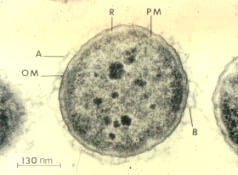Difference between revisions of "Aeromonas species - Overview"
Jump to navigation
Jump to search
| (4 intermediate revisions by 2 users not shown) | |||
| Line 1: | Line 1: | ||
| − | {{ | + | {{review}} |
| − | |||
| − | |||
| − | |||
| − | |||
| − | |||
| − | |||
| − | |||
| − | |||
| − | |||
| − | }} | ||
[[File:aeromonas.png|right|thumb|250px|<small><center>Transmission electromicrograph of Aeromonas salmonicida. A = A layer, OM = bacterial outer membrane, R = rigid layer, PM = plasma membrane, B = pililike appendages. (Rocco C. Cipriano 2001, Wikimedia commons)</center></small>]] | [[File:aeromonas.png|right|thumb|250px|<small><center>Transmission electromicrograph of Aeromonas salmonicida. A = A layer, OM = bacterial outer membrane, R = rigid layer, PM = plasma membrane, B = pililike appendages. (Rocco C. Cipriano 2001, Wikimedia commons)</center></small>]] | ||
| Line 24: | Line 14: | ||
==Treatment== | ==Treatment== | ||
Treat with antibiotics including Cephalosporins. | Treat with antibiotics including Cephalosporins. | ||
| − | + | [[Category:To_Do_-_AimeeHicks]] | |
| − | + | [[Category:Aeromonas_species]] | |
| − | |||
| − | |||
| − | |||
| − | |||
| − | |||
| − | |||
| − | [[Category:Aeromonas_species | ||
[[Category:Expert_Review]] | [[Category:Expert_Review]] | ||
Revision as of 15:02, 16 July 2010
| This article has been peer reviewed but is awaiting expert review. If you would like to help with this, please see more information about expert reviewing. |
Overview
Aeromonas are Gram negative, rod shaped bacteria that are found in aquatic environments. They are opportunistic pathogens and can be found in fresh water and the oral cavity, and skin of fish and reptiles. A major disease associated with Aeromonas is gastroenteritis.
Characterisitics
The bacteria are motile, straight rods. They are catalase and oxidase positive and are facultative anaerobes. They are able to grow on non-enriched media, although a NaCl supplementation is required for Vibrio species. Aeromonas morphologically resemble the Enterobacteriaceae family.
Diagnosis
Aeromonas can be identified by isolation from lesions. The bacteria is widespread in environments and can therefore be difficult to detect.
Treatment
Treat with antibiotics including Cephalosporins.
